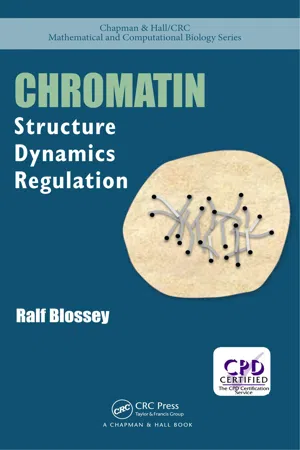
eBook - ePub
Chromatin
Structure, Dynamics, Regulation
Ralf Blossey
This is a test
Buch teilen
- 172 Seiten
- English
- ePUB (handyfreundlich)
- Über iOS und Android verfügbar
eBook - ePub
Chromatin
Structure, Dynamics, Regulation
Ralf Blossey
Angaben zum Buch
Buchvorschau
Inhaltsverzeichnis
Quellenangaben
Über dieses Buch
An invaluable resource for computational biologists and researchers from other fields seeking an introduction to the topic, Chromatin: Structure, Dynamics, Regulation offers comprehensive coverage of this dynamic interdisciplinary field, from the basics to the latest research. Computational methods from statistical physics and bioinformatics are detailed whenever possible without lengthy recourse to specialized techniques.
Häufig gestellte Fragen
Wie kann ich mein Abo kündigen?
Gehe einfach zum Kontobereich in den Einstellungen und klicke auf „Abo kündigen“ – ganz einfach. Nachdem du gekündigt hast, bleibt deine Mitgliedschaft für den verbleibenden Abozeitraum, den du bereits bezahlt hast, aktiv. Mehr Informationen hier.
(Wie) Kann ich Bücher herunterladen?
Derzeit stehen all unsere auf Mobilgeräte reagierenden ePub-Bücher zum Download über die App zur Verfügung. Die meisten unserer PDFs stehen ebenfalls zum Download bereit; wir arbeiten daran, auch die übrigen PDFs zum Download anzubieten, bei denen dies aktuell noch nicht möglich ist. Weitere Informationen hier.
Welcher Unterschied besteht bei den Preisen zwischen den Aboplänen?
Mit beiden Aboplänen erhältst du vollen Zugang zur Bibliothek und allen Funktionen von Perlego. Die einzigen Unterschiede bestehen im Preis und dem Abozeitraum: Mit dem Jahresabo sparst du auf 12 Monate gerechnet im Vergleich zum Monatsabo rund 30 %.
Was ist Perlego?
Wir sind ein Online-Abodienst für Lehrbücher, bei dem du für weniger als den Preis eines einzelnen Buches pro Monat Zugang zu einer ganzen Online-Bibliothek erhältst. Mit über 1 Million Büchern zu über 1.000 verschiedenen Themen haben wir bestimmt alles, was du brauchst! Weitere Informationen hier.
Unterstützt Perlego Text-zu-Sprache?
Achte auf das Symbol zum Vorlesen in deinem nächsten Buch, um zu sehen, ob du es dir auch anhören kannst. Bei diesem Tool wird dir Text laut vorgelesen, wobei der Text beim Vorlesen auch grafisch hervorgehoben wird. Du kannst das Vorlesen jederzeit anhalten, beschleunigen und verlangsamen. Weitere Informationen hier.
Ist Chromatin als Online-PDF/ePub verfügbar?
Ja, du hast Zugang zu Chromatin von Ralf Blossey im PDF- und/oder ePub-Format sowie zu anderen beliebten Büchern aus Informatica & Programmazione di giochi. Aus unserem Katalog stehen dir über 1 Million Bücher zur Verfügung.
Information
Contents
List of Figures
List of Tables
Preface
CHAPTER 1 ▪ DNA and the nucleosome
CHAPTER 2 ▪ DNA elasticity and topology
CHAPTER 3 ▪ Gene regulation without and with chromatin
CHAPTER 4 ▪ Histones and histone-acting enzymes
CHAPTER 5 ▪ Regulating chromatin
CHAPTER 6 ▪ Chromatin beyond transcription: splicing repair and replication
CHAPTER 7 ▪ Conclusions and Outlook
Index
List of Figures
1.1 The molecular structure of DNA
1.2The X-ray diffraction pattern of DNA
1.3 Schematic views of a nucleosome
1.4 Dinucleotide positioning preferences
1.5 Dinucleotide steps
1.6 Equilibrium constants for nucleosome positioning sequences
1.7 Nucleosomes on a one-dimensonal string
1.8 Statistical positioning of nucleosomes
2.1 Local radius of curvature and torsion
2.2 DNA tethered to a surface and Euler angles
2.3 Tangent vectors to a curve
2.4 An optical trap and measuring tethered DNA
2.5 Supercoiling experiment with magnetic tweezers
2.6 Force-extension curve of λ-phage DNA
2.7 Supercoiling measurements
2.8 Supercoiling due to transcription
2.9 Ribbon representation of a DNA molecule
2.10 Closing the ribbon to a circle
2.11 Closing the ribbon to a circle, but with a twist
2.12 The four possibilities of strand encounters
2.13 Relaxed ribbon, transforming twist into writhe
2.14 Twisted and writhed DNA minicircles
2.15 Single-molecule experiment with topoisomerase II
2.16 Kinetic proofreading scenario of topoisomerase II
2.17 Force-extension curves of a chromatin fiber and a nucleosome
2.18 Schematic of metastable nucleosome conformations upon pulling a chromatin fiber
2.19 Nucleosomes on DNA
2.20 Sketch of the solenoid and zig-zag packing in the 30 nm fiber
2.21 A cellular nucleus
2.22 Chromatin territories: the wool model
2.23 Micro-irradiation experiment on chromatin
2.24 Chromatin structure analysis with polymer models
3.1 A λ-phage infecting E. coli
3.2 Regulatory programming of an operator segment in λ-phage
3.3 Predicted repression curves
3.4 Genome-wide nucleosome occupancy
3.5 Distribution of the apparent chemical potential
3.6 Nucleosome positioning at a housekeeping gene
3.7 The probability distribution P (n) of the self-regulated gene for different parameter values
4.1 Histone structure
4.2 Association of histone modifications with promoters
4.3 Phylogenetic tree of bromodomains
4.4 Bromodomains of GCN5
4.5 Dissociation free energies
4.6 Chromatin remodeler domains
4.7 Cryo-EM reconstruction of the remodeler SWR1
4.8 RSC remodeling assay I: construction
4.9 RSC remodeling assay II: force-time trace
4.10 Speed and processivity of RSC
4.11 FRET assay for ACF remodeling
4.12 Schematic drawing of ACF on a nucleosome
4.13 Three-state model of ACF remodeling
4.14 Extended two-motor model of ACF
4.15 ProbabilitydistributionP(n,t)ofanucleosomeofaDNAstrand
4.16 Motor velocity and effective diffusion constant in the one- motor model
4.17 Motor velocity and effective diffusion constant: ATP dependence of the one-motor model
4.18 Probability density function of remodeling intermediates in the two-motor model
4.19 Motor velocity and effective diffusion constant in the two- motor model
4.20 Effect of sampling between the motors
4.21 Motor velocity in the two-motor model for different ATP concentrations
4.22 Velocity profiles of the continuum Fokker-Planck model and the discrete master equation model for nucleosome remodeling by ACF
4.23 Near steady-state probabilities of the continuum Fokker-Planck model
4.24 Kinetic Monte Carlo of nucleosome positioning with ACF
4.25 Remodeling of a nucleosomal array with ACF
5.1 The regulated nucleosome mobility model
5.2 Kinetic proofreading of chromatin remodeling
5.3 The regulatory region of the IFN-β gene
5.4 Bifurcations in the epigenetic model
5.5 The floral...